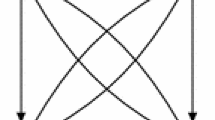Abstract
Reciprocal preferences have been introduced in the literature of social choice theory in order to deal with preference intensities. They allow individuals to show preference intensities in the unit interval among each pair of options. In this framework, majority based on difference in support can be used as a method of aggregation of individual preferences into a collective preference: option \(a\) is preferred to option \(b\) if the sum of the intensities for \(a\) exceeds the aggregated intensity of \(b\) by a threshold given by a real number located between 0 and the total number of voters. Based on a three dimensional geometric approach, we provide a geometric analysis of the non-transitivity of the collective preference relations obtained by majority rule based on difference in support. This aspect is studied by assuming that each individual reciprocal preference satisfies a \(g\)-stochastic transitivity property, which is stronger than the usual notion of transitivity.











Similar content being viewed by others
Notes
In this article, we assume that individuals vote sincerely, so that the possibility of strategic voting is not considered.
By symmetry, we also consider the case \(bP_k a\), \(cP_k b\) and \(\lnot (cP_k a)\).
Recall that a trirectangular tetrahedron is a tetrahedron where all three face angles at one vertex are right angles.
References
Barrett CR, Pattanaik PK, Salles M (1986) On the structure of fuzzy social welfare functions. Fuzzy Sets Syst 19:1–10
Basu K (1984) Fuzzy revealed preference theory. J Econ Theory 32:212–227
Cook WD, Kress M (1985) Ordinal ranking with intensity of preference. Manag Sci 31:26–32
Dasgupta M, Deb R (1996) Transitivity and fuzzy preferences. Soc Choice Welf 13(3):305–318
De Baets B, De Meyer H (2005) Transitivity frameworks for reciprocal relations: cycle-transitivity versus FG-transitivity. Fuzzy Sets Syst 152:249–270
De Baets B, De Meyer H, De Schuymer B, Jenei S (2006) Cyclic evaluation of transitivity of reciprocal relations. Soc Choice Welf 26:217–238
Dubois D, Prade H (1980) Fuzzy sets and systems: theory and applications. Mathematics in science and engineering. Academic Press, New York
García-Lapresta JL (2006) A general class of simple majority decision rules based on linguistic opinions. Inf Sci 176:352–365
García-Lapresta JL, Llamazares B (2000) Aggregation of fuzzy preferences: some rules of the mean. Soc Choice Welf 17(4):673–690
García-Lapresta JL, Llamazares B (2001) Majority decisions based on difference of votes. J Math Econ 35:463–481
García-Lapresta JL, Llamazares B (2010) Preference intensities and majority decisions based on difference of support between alternatives. Group Decis Negot 19:527–542
García-Lapresta JL, Meneses LC (2005) Individual-valued preferences and their aggregation: consistency analysis in a real case. Fuzzy Sets Syst 151(2):269–284
Gehrlein WV, Lepelley D (2012) The value of research based on simple assumptions about voters’ preferences. In: Felsenthal DS, Machover M (eds) Electoral systems: paradoxes, assumptions and procedures. Springer, Berlin, pp 173–200
Houy N (2007) Some further characterizations for the forgotten voting rules. Math Soc Sci 53:111–121
Llamazares B (2004) Simple and absolute special majorities generated by OWA operators. Eur J Oper Res 158:707–720
Llamazares B (2006) The forgotten decision rules: majority rules based on difference of votes. Math Soc Sci 51:311–326
Llamazares B (2007) Choosing OWA operator weights in the field of social choice. Inf Sci 177:4745–4756
Llamazares B, García-Lapresta JL (2003) Voting systems generated by quasiarithmetic means and OWA operators. In: Fodor J, De Baets B (eds) Principles of fuzzy preference modelling and decision making. Academia Press, Ghent, pp 195–213
Llamazares B, García-Lapresta JL (2008) Extension of some voting systems to the field of gradual preferences. In: Bustince H, Herrera F, Montero J (eds) Fuzzy sets and their extensions: representation, aggregation and models. Springer, Berlin, pp 292–310
Llamazares B, Perez-Asurmendi P, García-Lapresta JL (2013) Collective transitivity in majorities based on difference in support. Fuzzy Sets Syst 216:3–15
McLean I, Urken AB (1995) Classics of social choice. The University of Michigan Press, Ann Arbor
Meek BL (1975) A transferable voting system including intensity of preference. Math Sci Hum 50:23–29
Morales JI (1797) Memoria matemática sobre el cálculo de la opinion en las elecciones. Imprenta Real, Madrid
Nurmi H (1981) Approaches to collective decision making with fuzzy preference relations. Fuzzy Sets Syst 6:249–259
Nurmi H (2008) Fuzzy social choice: a selective retrospect. Soft Comput 12:281–288
Orlovsky SA (1978) Decision making with a fuzzy preference relation. Fuzzy Sets Syst 1:155–167
Ovchinnikov SV (1981) Structure of fuzzy binary relations. Fuzzy Sets Syst 6:169–195
Saari DG (1994) Geometry of voting. Springer, Berlin
Saari DG (1995) Basic geometry of voting. Springer, Berlin
Sen AK (1970) Collective choice and social welfare. Holden-Day, San Francisco
Tanino T (1984) Fuzzy preference orderings in group decision making. Fuzzy Sets Syst 12:117–131
Zadeh LA (1971) Similarity relations and fuzzy orderings. Inf Sci 3(2):177–200
Acknowledgments
For helpful comments received, the authors want to thank an associate editor, two anonymous referees, W.V. Gehrlein, Y. Koriyama, V. Merlin, and the participants of the 13th SAET conference. Financial support by the National Agency for Research (ANR)—research program “Dynamic Matching and Interactions: Theory and Experiments” (DynaMITE) ANR. BLANC—and the “Mathématiques de la décision pour l’ingénierie physique et sociale” (MODMAD) project is gratefully acknowledged.
Author information
Authors and Affiliations
Corresponding author
Rights and permissions
About this article
Cite this article
Baron, R., Diss, M., Rémila, E. et al. A geometric examination of majorities based on difference in support. Soc Choice Welf 45, 123–153 (2015). https://doi.org/10.1007/s00355-015-0870-y
Received:
Accepted:
Published:
Issue Date:
DOI: https://doi.org/10.1007/s00355-015-0870-y




